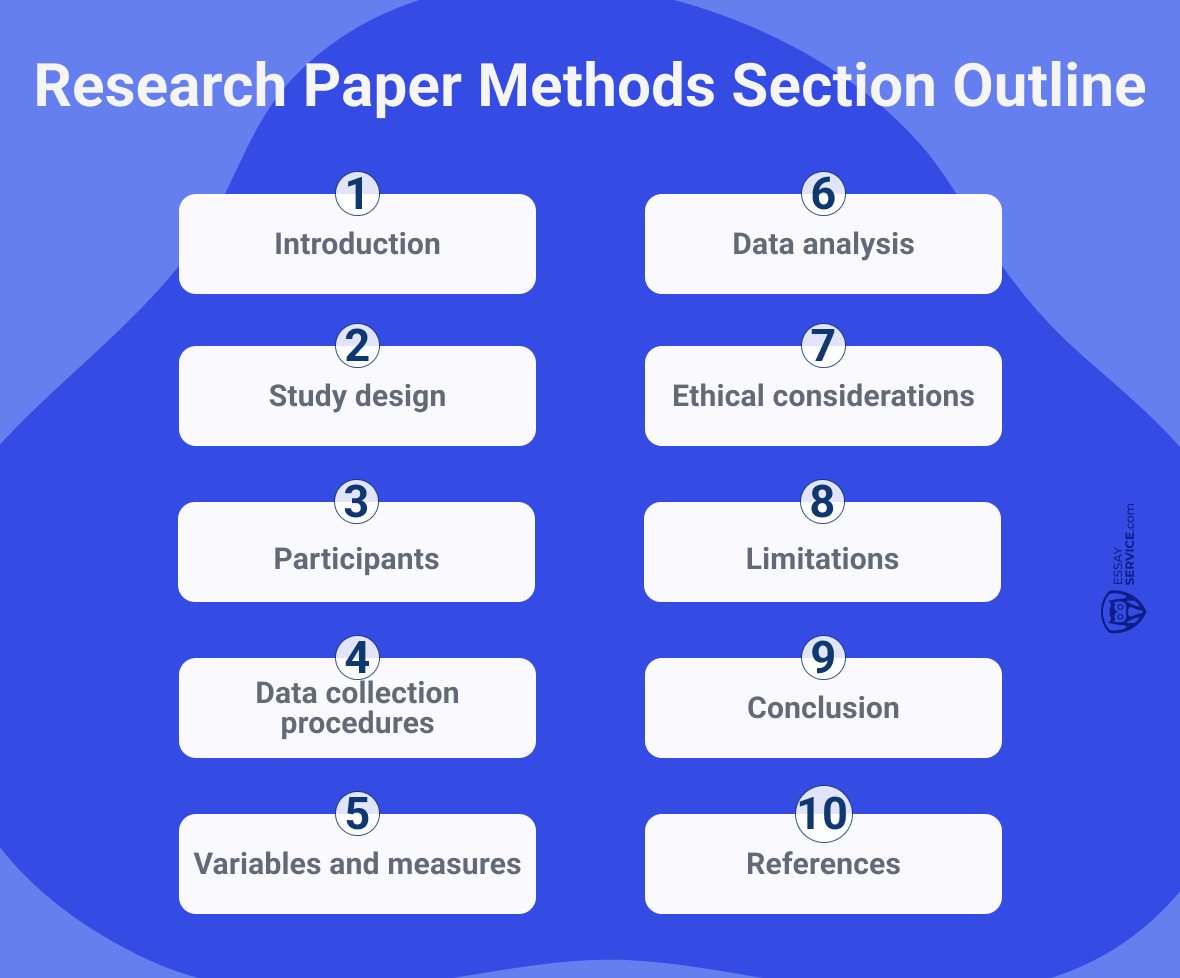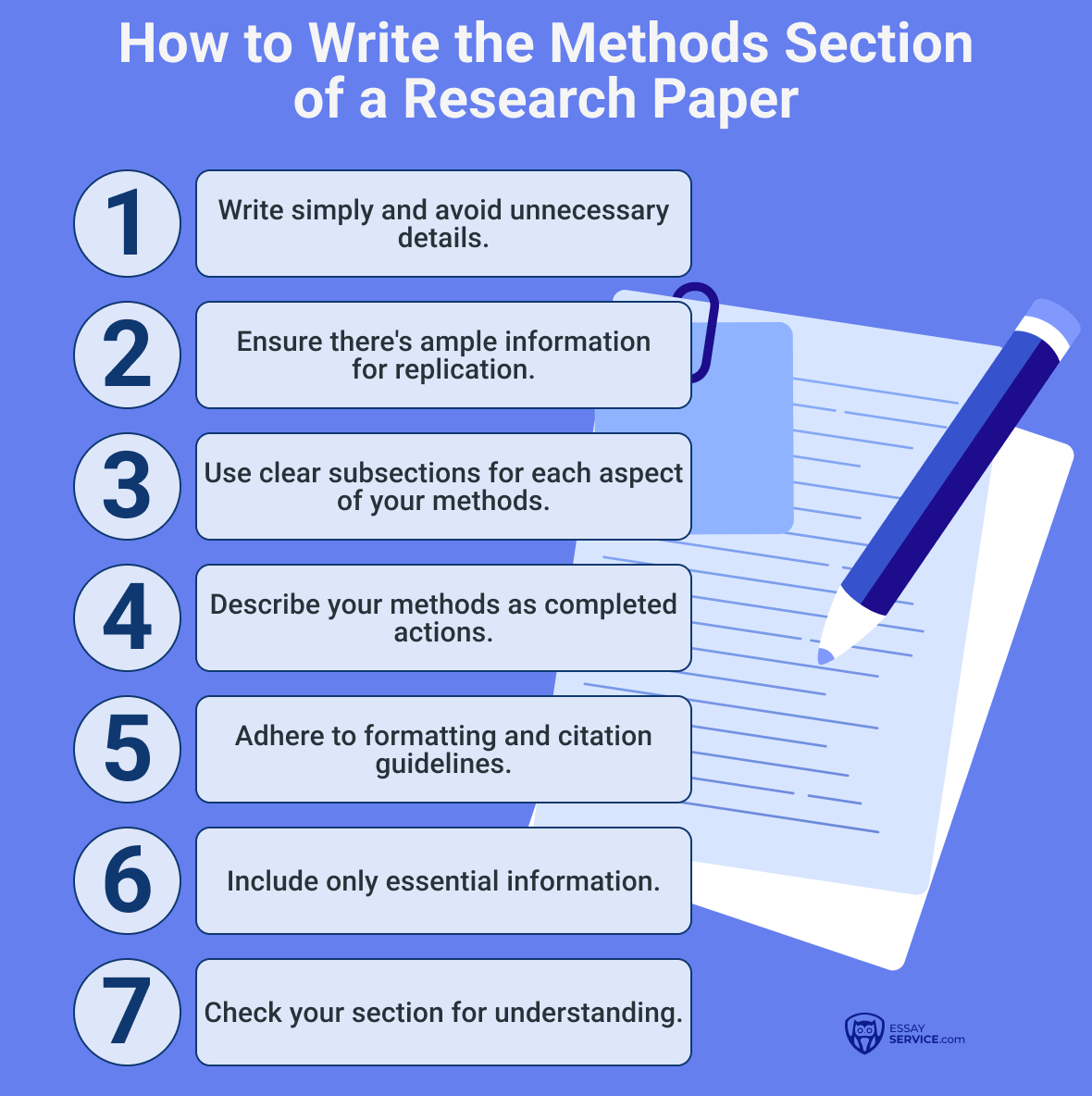Writing the methods section of your research paper is like giving someone else the recipe for your experiment. It's where you lay out all the steps you took so that other researchers can understand what materials and methods in research paper you used. In this article, we'll break down how to write the methods section of a research paper effectively, covering everything from what to include to how to avoid common mistakes so that your methods are clear, rigorous, and easy for others to follow.
What Is the Methods Section of a Research Paper?
The methods section in research paper is a dedicated portion where authors detail the procedures, techniques, and materials used to conduct their study. Essentially, it's a step-by-step guide that outlines how the research was carried out, from the initial design to the collection and analysis of data. This section typically includes information about the study design, participants or subjects involved, data collection methods, instrumentation, statistical analyses, and other pertinent details necessary for replicating the study.
What is the purpose of the methods section in a research paper beyond merely documenting the technical aspects of the research process? Firstly, it ensures transparency and accountability by providing readers with a clear understanding of how the study was conducted. This transparency is essential for evaluating the reliability and validity of the research findings. Secondly, the methods section enables other researchers to replicate the study, validating its results and building upon the existing body of knowledge. By providing sufficient detail and clarity, authors facilitate scientific inquiry advancement and contribute to their field's cumulative progress. Overall, the methods section plays a fundamental role in upholding the integrity and credibility of scientific research. To cope with this assignment, it’s essential to understand how to organize a research paper, including methodology.
Dealing with a Complex Research Paper?
Streamline your writing progress with professional writers’ expertise!
Why Is the Methods Section Important?
The methods part of a research paper, often nestled within the confines of a research paper, meticulously delineates the procedures, techniques, and tools employed throughout the study. Its significance transcends mere documentation, as it embodies the essence of scientific rigor, transparency, and reproducibility. Understanding the importance of the methods section is crucial for researchers striving to uphold the standards of integrity and credibility in their work. There are 10 reasons why writing the methods section of a research paper is crucial:
- Transparency. It offers a transparent account of the research process, allowing readers to assess the reliability and validity of the findings.
- Replicability. By providing a detailed roadmap, it enables other researchers to replicate the study, thus verifying its results and advancing scientific knowledge.
- Accountability. It ensures researchers are accountable for their methodologies, fostering trust and confidence in the scientific community.
- Identification of Limitations. It helps identify potential limitations or biases in the study design and execution, guiding future research directions.StandardizationIt promotes standardized reporting practices, enhancing the clarity and comparability of research across different studies.
- Ethical Considerations. It underscores adherence to ethical guidelines and regulations governing research conduct, safeguarding the welfare of participants.
- Methodological Innovation. It encourages methodological innovation by highlighting novel approaches and techniques employed in the study.
- Meta-analysis and Synthesis. It facilitates meta-analysis and synthesis of research findings by providing a comprehensive overview of the study methodology.
- Peer Review. It forms the basis for peer review evaluation, allowing experts to assess the methodological soundness of the research.
- Educational Resource. It serves as an educational resource for students and novice researchers, offering insights into the research process and methodology.

Methods Section of Research Paper Outline
The methods section of a research paper provides a detailed account of how the study was conducted, encompassing various key elements crucial for understanding and replicating the research. What does the methods section of a research paper contain? It typically outlines the study design, whether experimental, observational, qualitative, or a combination thereof, setting the foundation for the investigation. Additionally, it delves into the specifics of participant selection, including criteria for inclusion and exclusion, recruitment procedures, and details about the sample size.
Furthermore, the materials and methods section elucidates the procedures employed for data collection, encompassing the instruments used, their development or selection, and the administration process. Overall, the methods section serves as a comprehensive guide that ensures transparency, rigor, and replicability in scientific research endeavors. Here’s an example of a methods section outline for a research paper:

Introduction
- Brief overview of the research study.
- Importance of the methods section in scientific research.
Study Design
- Description of the overall study design (e.g., experimental, observational, qualitative).
- The rationale for selecting the specific design.
Participants
- A. Description of the target population.
- B. Inclusion and exclusion criteria.
- C. Recruitment procedures.
- D. Sample size determination.
Data Collection Procedures
- Description of data collection instruments (e.g., surveys, interviews, observations).
- Development or selection of measurement tools.
- Procedures for administering instruments.
- Data collection timeline.
Variables and Measures
- Operational definitions of variables.
- Description of primary and secondary outcome measures.
- Reliability and validity of measurement tools.
Data Analysis
- Description of statistical or qualitative analysis methods.
- Assumptions underlying chosen analyses.
- Software used for data analysis.
- Treatment of missing data.
Ethical Considerations
- Institutional Review Board (IRB) approval.
- Informed consent procedures.
- Protection of participant confidentiality and privacy.
- Handling of sensitive data.
Limitations
- Identification of potential limitations in the study design or methodology.
- Discussion of how limitations may impact the interpretation of results.
Conclusion
- Recap the key components of the methods section.
- Importance of rigorous methodology for scientific research.
References
- Citations for any sources referenced in the methods section.
- If you want to learn more about how to write a good research paper, please consult our guide.
Essential Parts of a Methods Section
Study Design
The research design delineates the framework guiding the study, whether it's experimental, observational, qualitative, or mixed methods. This aspect shapes the methodology, defining how data will be collected, analyzed, and interpreted. It sets the foundation for addressing research questions or hypotheses and determines the study's generalizability and validity.
Ethical Approval
Ethical approval signifies endorsement obtained from an Institutional Review Board (IRB) or ethics committee, ensuring research compliance with ethical standards. This process involves reviewing study protocols to protect participants' rights, welfare, and privacy, minimizing potential risks and obtaining informed consent.
Setting
The setting specifies the physical, social, or organizational context where the research occurs, providing crucial contextual information influencing data collection and interpretation. It defines the study's environment, including its geographic location, organizational structure, and cultural milieu, enhancing its relevance and applicability.
Participants
This section describes the individuals or entities involved in the study, encompassing details about the target population, demographics, inclusion and exclusion criteria, and sample size determination. Participants are central to data collection, and their characteristics inform the study's scope, generalizability, and external validity.
Measures
Instruments or measures are tools used to collect data, such as surveys, questionnaires, interviews, or observation protocols. This component elucidates their development or selection, including information about validity, reliability, and appropriateness for assessing variables of interest. It ensures that data collection instruments accurately measure the constructs under investigation, enhancing the study's credibility and validity.
Procedures
Procedures outline step-by-step protocols for data collection or interventions implemented in the study. This section details actions taken by researchers, including participant recruitment, data collection methods, experimental manipulations, or interventions administered. It ensures consistency and replicability in the research process, enhancing the study's reliability and facilitating comparisons with similar studies.
Data Collection
Data collection entails gathering information or observations relevant to the study's objectives, following outlined procedures. It involves implementing data collection methods to obtain empirical evidence, including timing, location, and techniques. This component describes how data were acquired, enhancing transparency and ensuring data collection aligns with research objectives and methodology.
Data Analysis
Data analysis involves interpreting collected data to address research questions or hypotheses. It encompasses applying statistical techniques or qualitative methods to analyze data, drawing conclusions and implications. This section outlines specific statistical tests or analytical approaches used and underlying assumptions. It ensures rigor in data analysis, enhancing the study's validity and credibility.
Have You Already Finished Your Methods Section?
If there are stumbling blocks down the academic road, use our expert writing service!
Tips for Writing a Methods Section Using the APA Format
Here are some hints specifically relevant to writing the APA methods section:

- Clear Heading. Begin the methods section with a centered heading "Method" (without the "s") in bold font.
- Subheadings. Consider using subheadings to divide the methods section into distinct subsections, such as "Participants," "Materials," "Procedure," and "Data Analysis."
- Verb Tense. Write the methods section in the past tense, describing what was done during the study. However, use the present tense to describe facts or theories.
- Conciseness. Be concise and to the point when describing each aspect of the methodology. Focus on providing essential details without unnecessary elaboration.
- Specificity. Provide specific details about the research design, including the type of study (e.g., experimental, observational), the duration of the study, and any specific procedures followed.
- Participant Characteristics. Describe the demographic characteristics of the participants, such as age, gender, and any relevant inclusion or exclusion criteria.
- Materials and Instruments. Clearly list and describe any materials, tools, or instruments used in the study, including their names, manufacturers, and versions.
- Procedure. Describe the step-by-step procedures followed in the study, including how data were collected, any interventions administered, and the sequence of tasks.
- Ethical Considerations. Discuss any ethical considerations, such as obtaining informed consent from participants, ensuring confidentiality, and obtaining approval from an Institutional Review Board (IRB).
- APA Style Citations. If you reference specific sources or instruments in the methods section, ensure that you cite them correctly according to APA style guidelines.
What to Include in the Methods Section of a Research Paper?
In the methods section of a research paper, authors meticulously outline the framework and procedures used to conduct their study. This section serves as a roadmap for fellow researchers, providing insight into the research design chosen, whether it be experimental, observational, or qualitative. Additionally, it's paramount to thoroughly describe the characteristics of the study's participants, including any criteria for inclusion or exclusion and the methods used for recruitment.
Furthermore, the methods section delves into the nitty-gritty of data collection procedures, elucidating the tools, instruments, or measures utilized and their validation processes, if applicable. Authors must clarify how data were gathered, whether through surveys, interviews, observations, or other means. Moreover, ethical considerations take center stage in this section, with authors detailing steps taken to obtain informed consent from participants and secure approval from relevant ethics committees.
Overall, the methods section plays a pivotal role in upholding the integrity and transparency of scientific research. By offering a thorough account of the research methodology, the authors enable readers to understand, evaluate, and potentially replicate the study's findings. Clarity, detail, and adherence to ethical standards are essential in crafting this crucial portion of a research paper.
Avoid These Common Mistakes When Writing a Method Section of Research Paper
When working on the section with materials and methods in research paper, several common mistakes can compromise the study's clarity, accuracy, and reproducibility. Be sure to avoid them:
- Insufficient detail about the research design and methodology.
- Overlooking the description of participant characteristics and recruitment procedures.
- Failing to detail data collection procedures and instruments used adequately.
- Omitting information about ethical considerations, such as informed consent procedures and IRB approval.
- Presenting methods in a disorganized or haphazard manner.Inappropriate verb tense use, such as mixing past and present tense inconsistently.
- Neglecting to discuss potential limitations or biases in the study design and execution.
- Use a custom research paper writing service powered by professional writers to receive an all-new document where every section is up to the mark.
Example of Methods Section in Research Paper
Use this methods section of research paper example to gain practical insight into how this part of the assignment has to be performed:
Participants:
The study included 150 undergraduate students (75 females, 75 males) recruited from a local university. Participants were aged between 18 and 25 years old (M = 20.3, SD = 1.4). They were recruited through advertisement flyers distributed across campus and were compensated with extra credit in psychology courses.
Materials:
- Questionnaire: A self-report questionnaire was developed to assess participants' levels of stress, anxiety, and depression. The questionnaire consisted of validated scales, including the Perceived Stress Scale (PSS-10), the Generalized Anxiety Disorder 7-item Scale (GAD-7), and the Patient Health Questionnaire (PHQ-9) for depression.
- Experimental Task: Participants completed a computer-based cognitive task designed to induce mild stress. The task involved solving a series of math problems under time pressure. Performance metrics and physiological responses (heart rate, skin conductance) were recorded during the task.
Procedure:
- Recruitment and Screening: Interested participants signed up for the study through an online recruitment system. They were screened for eligibility based on age (18-25 years old) and absence of diagnosed mental health disorders.
- Informed Consent: Upon arrival at the laboratory, participants were provided with a detailed explanation of the study procedures and objectives. Informed consent was obtained from all participants before participation.
- Questionnaire Administration: Participants completed the self-report questionnaire in a quiet laboratory setting. They were instructed to respond honestly and to the best of their abilities.
- Experimental Task: After completing the questionnaire, participants were seated in front of a computer and briefed on the cognitive task. They were informed that they would be performing a series of math problems under time pressure and that their performance would be monitored.
- Physiological Monitoring: Physiological sensors were attached to participants to measure heart rate and skin conductance. Baseline measurements were recorded for 5 minutes prior to the start of the cognitive task.
- Cognitive Task: Participants completed the math task, which consisted of 30 arithmetic problems of varying difficulty levels. Each problem was presented on the computer screen for 30 seconds, and participants were instructed to solve as many problems as possible within the time limit.
- Post-task Measures: Following completion of the cognitive task, participants were asked to rate their subjective stress levels using a visual analog scale (VAS) ranging from 0 (not stressed at all) to 100 (extremely stressed).
- Debriefing: Participants were fully debriefed regarding the purpose of the study and any deception involved. They were provided with information about resources for mental health support and were compensated for their time.
- Data Analysis: Data obtained from the questionnaires and experimental task were analyzed using statistical software (e.g., SPSS, R). Descriptive statistics were calculated for demographic variables, and inferential statistics (e.g., t-tests, ANOVA) were employed to examine relationships between variables of interest. Additionally, regression analyses were conducted to explore predictors of stress, anxiety, and depression levels. All statistical tests were two-tailed, and significance was set at p < 0.05.
FAQ
What Should Be in the Methods Section of a Research Paper?
In the methods section of a research paper, it is essential to provide a detailed description of how the study was conducted, including information about participants, materials, procedures, and data analysis methods. This section ensures transparency and replicability of the study, allowing readers to evaluate the rigor and validity of the research findings. It typically begins with describing the study's participants, including demographic information such as age, gender, and any relevant characteristics. Following this, the materials used in the study, such as questionnaires, experimental tasks, or equipment, should be described in sufficient detail to allow for replication. The procedures section outlines the steps to carry out the study, including recruitment procedures, data collection methods, and any ethical considerations. Finally, the data analysis methods used to analyze the collected data should be clearly explained, including any statistical techniques employed to test hypotheses or explore relationships between variables.
How to Write a Methods Section APA?
When writing a methods section APA style, it is important to adhere to the guidelines outlined in the Publication Manual of the American Psychological Association (APA). The methods section should be structured clearly and concisely, using subsections to organize information about participants, materials, procedures, and data analysis. Each subsection should begin with a bolded heading (e.g., Participants, Materials, Procedure) aligned to the left margin. Within each subsection, relevant details should be provided logically, using past tense to describe what was done. When describing participants, include information about sample size, demographics, and inclusion/exclusion criteria. For materials, provide details about the instruments or measures, including any relevant psychometric properties. The procedures subsection outlines the steps taken to conduct the study, from participant recruitment to data collection and analysis. Finally, in the data analysis subsection, describe the statistical techniques used to analyze the data and test hypotheses.
Which Information Is Not Included in the Methodology Section in a Research Article?
The methodology section in a research article typically includes detailed information about the study's design, participants, materials, procedures, and data analysis methods. However, certain types of information may not be included in this section, such as results or interpretations of findings. The methodology section focuses solely on describing how the study was conducted rather than discussing the outcomes or implications of the research. Additionally, background information or literature review material is usually not included in the methodology section, as its purpose is to provide a clear and concise description of the study methods. Instead, this information is typically presented in the paper's introduction or literature review sections. Overall, the methodology section provides readers with a comprehensive understanding of the study's procedures and methods, allowing for evaluation of the research's validity and reliability.
Summary
Knowing how to write the methods section of a research paper is really important because it's like giving a recipe for your study. Just like a recipe tells someone how to cook a dish step by step, the methods section tells other researchers exactly how you did your study. This is crucial because it helps others understand and trust your findings.
When you provide clear details about things like who participated, what materials you used, and how you analyzed your data, it makes it easier for others to repeat your study and see if they get the same results. In the end, a well-written methods section is like a roadmap that guides others through your research process, ensuring transparency and reliability in scientific discovery. For more research paper writing insights, please consult our EssayService subjects section.
You Might Also Like
New posts to your inbox!
Your submission has been received!



.png)

